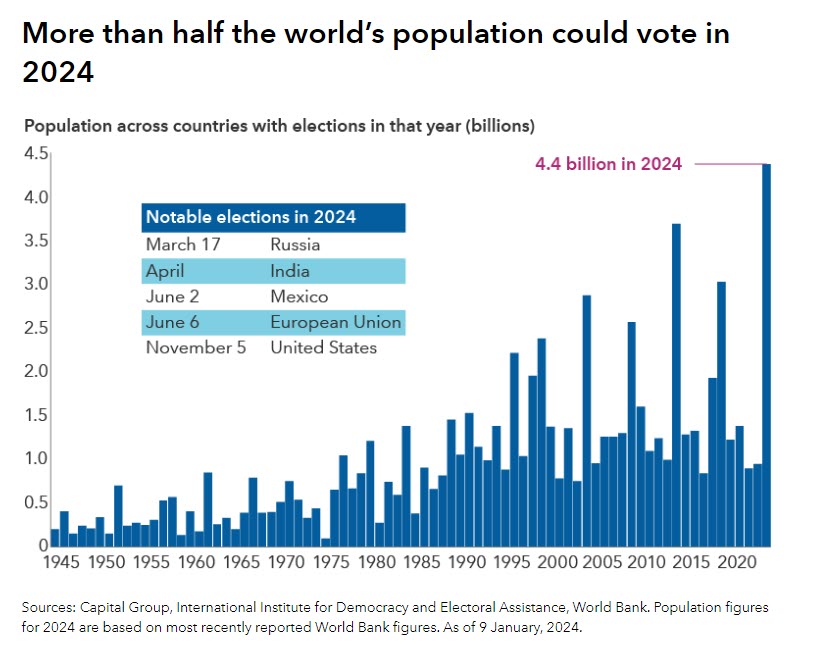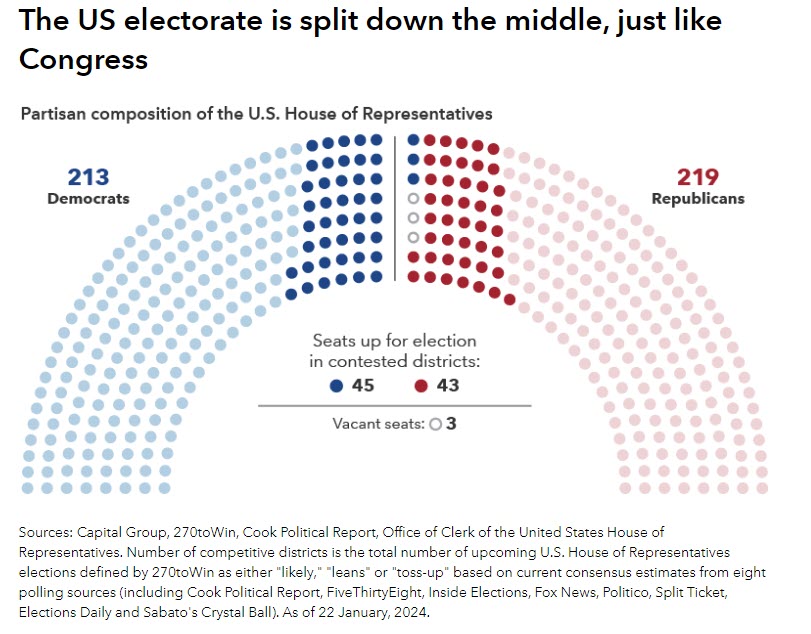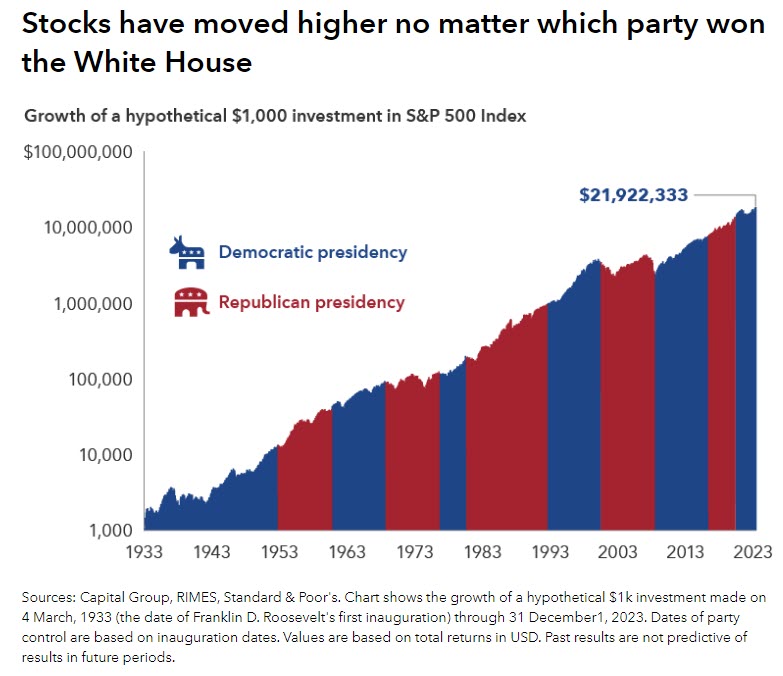We are often asked – what will be the impact on the markets in an election year. The following article addresses this.
This is the biggest election year in world history. Seventy-six countries — home to roughly 4.4 billion people — will hold political contests in 2024.
Some have already taken place. Last month, Taiwan elected a pro-independence candidate who may aggravate already tense relations with China. A few elections are on the way, but largely decided. For instance, no one expects Russian President Vladimir Putin to face a serious challenge on 17 March.
Then there is the event the entire world will be watching: US elections on 5 November, when the President and Vice President, 34 Senate seats and all 435 members of the House of Representatives will be up for election. Numerous state and local offices, as well as many important ballot measures, will be contested on that day as well.

With that global backdrop in mind, here are four things that, in our view, will shape the outcome of what is likely to be one of the most pivotal US elections in a generation:
1. It’s (still) the economy, stupid
Borrowing a phrase from the 1992 campaign, the 2024 election will be dominated by economic issues. Are we headed for a recession? When will inflation return to normal? Will the Federal Reserve cut interest rates? Did people’s finances emerge from the pandemic better or worse?
For President Joe Biden, who is likely to face off against former President Donald Trump, the latest economic indicators are good news. The US economy, as measured by gross domestic product, grew by 3.1% over the past year, far above expectations. Inflation has declined from 9.1% in the summer of 2022 to 3.4% in December. And US stocks have set a series of new record highs so far this year.
On the other hand, rising prices at the supermarket, unaffordable homes and the skyrocketing national debt are likely to be the focus of opposition candidates from Trump on down. Fear of an impending recession appears to have dissipated, but there are plenty of economic indicators still pointing in that direction.
Fair or not, US presidents win or lose elections based on perceptions of the economy. Whether it was Herbert Hoover in 1932, toppled by the Great Depression, or Jimmy Carter, who lost the 1980 election amid the economic malaise of the late 1970s, kitchen table issues often determine election outcomes. This year probably will be no different
2. It all comes down to a few battleground states
In the quest for control of the White House, the Senate and the House of Representatives, the final tallies in battleground states are likely to be very close again. Winners may be determined by razor-thin margins. And whichever party comes out ahead, Democrat or Republican, there will almost certainly be complaints of unfair tactics, calls for recounts and court challenges. There is a good chance we won’t know the outcome of some races, including the presidency, for days after the election.
The fact is, the country is split down the middle. We can see it clearly in the makeup of Congress today. Republicans control the House by a three-seat majority. Democrats and Independents control the Senate by a one-seat majority. In the last presidential election, if 45,000 votes in three states had gone the other way, Trump would be the sitting incumbent.

If the battleground states sound familiar, it’s because they are the same as they were in 2020. The key states to watch this November are Arizona, Georgia, Michigan, Pennsylvania and Wisconsin. Those are the traditional swing states that could go either way. Two other states, North Carolina and Nevada, have also seen very close races in recent years, so they are often included on the watch list as well.
Once again, a handful of states and a small number of voters should be critical to the outcome. Fewer than 100,000 people are going to decide who will be the next president of the United States.
3. Tax policy will have the biggest long-term impact
Major tax cuts enacted under the Trump administration will be up for renewal in 2025. Whether they are extended or expire will depend a great deal on who controls the White House and Congress after the 2024 election.
The Tax Cuts and Jobs Act of 2017 brought significant changes to the federal tax code, resulting in generally lower individual and business taxes. By various estimates, it is expected to reduce federal revenue by nearly $1.5 trillion over 10 years. Supporters argue it boosts economic growth while critics say it worsens the national debt.
A second Trump administration, with the support of a Republican-controlled Congress, would likely extend major provisions of the act, while the Biden administration would probably look for alternatives, including raising taxes on businesses and individuals, although Biden has pledged that he would not raise taxes on people making less than $400,000 a year.
In addition, the US debt limit will come up for consideration again in the spring of 2025, creating renewed pressure on tax and spending initiatives. The national debt hit a new high of $34 trillion at the end of 2023.
With the annual deficit and the national debt much larger now than they were when Trump first came into office in 2016, these challenges will not be easily solved under either party. Changes to tax rates and retirement savings programs are nearly always on the table no matter who is in charge. When Washington is looking for ways to raise money, the retirement industry often comes under scrutiny, so we will be watching that closely as candidates for office unveil their economic proposals.
4. Don’t let politics derail your investment plan
In addition to economic issues, many others will come up for debate as the campaign season unfolds. Immigration, abortion, climate change and global trade will certainly be among them. In the realm of international relations, we will hear arguments about the wars in Ukraine and the Middle East, along with rising tensions between the US and China.
All of this may result in a degree of market volatility, particularly as we get closer to 5 November. Markets hate uncertainty and this election is likely to produce a lot of it. But there is one important point to keep in mind: Over the long term, going as far back as the 1930s, US stocks have nearly always been higher at the end of a president’s term in office than they were at the beginning, regardless of party affiliation.

Don’t allow politics to interfere with investment decisions. If you were flabbergasted when a reality TV star named Trump shocked the world by defeating Hillary Clinton in 2016, and you went to cash, you were right for one day. After that, you missed four years of very strong returns.
Conversely, if you were upset that a community organiser named Barack Obama was elected in 2009 — at the height of the financial crisis — and you got out of the market, you were right for about six weeks. After that, you missed out on one of the greatest bull markets in US history.
As the adage goes, time in the market is far more important than timing the markets.
Authors:
John Emerson works in global distribution as vice chair of Capital Group International, Inc. He has 23 years of industry experience, all with Capital Group. He served as the United States ambassador to the Federal Republic of Germany (2013-2017). In 2015, John was awarded the State Department’s Susan M. Cobb Award for Exemplary Diplomatic Service, which is given annually to one non-career ambassador, and in 2017 he was awarded the CIA Medal and the U.S. Navy’s Distinguished Public Service award. Prior to accepting the ambassadorial posting, John was president of Capital Group Private Client Services.
Reagan Anderson is a senior vice president of government relations at Capital Group. She has 23 years of industry experience and has been with Capital since 2015. She holds a bachelor’s degree from the Scripps School of Journalism at Ohio University.
